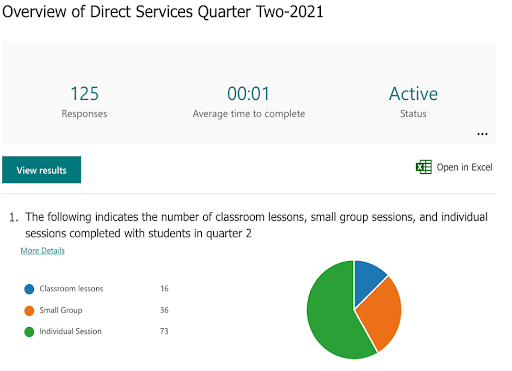When looking at your calendar in August, it’s hard to believe just how fast the school year will go. It can be both exciting and daunting to think about all you want to accomplish in a school year. As we close semester one and head into the second half of the school year, it’s a great time to reflect on your accomplishments thus far and the goals and aspirations you have for semester two. One way to guide your planning is by using data. You already know how important data is to a comprehensive school counseling program, but trying to wrap your head around a variety of data sources and planning your services and interventions accordingly can be overwhelming. In this blog I’ll break down 4 ways you can use data to kick-off the second semester.
Leverage Existing Data

Now that you have a semester under your belt, data sources from the first half of the year can be very useful. Some of these include attendance trends, discipline data, normative assessments (NWEA, Aimsweb, etc.), grade reports, and student voice surveys. These sources can shed light onto which students need academic or social emotional interventions. You can also gain valuable insight into achievement gaps which can guide your equity or school improvement work. These sources can be used as outcome data as well if you can show positive trends for students receiving intervention from you during first semester. For example, if you worked with a group of students with attendance concerns, you may be able to show an increase in their attendance rates since working with you. Another example could be implementing tier 2 supports in the area of emotion management with students receiving PBIS services. Your discipline data may show that their number of referrals has decreased since beginning the intervention. This knowledge will help you to know what is working well and should be continued as well as new areas to focus on.
“You can also gain valuable insight into achievement gaps which can guide your equity or school improvement work.”
Conduct a Needs Assessment
Teachers have a wealth of knowledge about student needs because of the amount of direct contact they have with them. A needs assessment is a great way to elicit their opinions through a structured format. You can develop your own needs assessment or research many from the internet that have already been created. Start by choosing categories that make sense for your student population. Some may include social skills, academic skills, emotion management, self management, family changes, or college/career planning. From there, come up with a few bullet points that are essential to each domain. The Indiana SEL competencies, ASCA Mindsets and Behaviors, or CASEL Framework are great resources for building your needs assessment. You can use this document as a jumping off point if you want to create your own. Distribute to teachers either electronically or in a paper format and ask them to indicate the areas of need they recognize in their students. You can use this information to build classroom lessons, small groups, or professional development opportunities for staff.
“Process data helps stakeholders see just how far-reaching your interventions are within your school.”
Compile Process Data
Process data is descriptive and communicates what happened during an intervention and who was impacted. Within the first few months of school, you’ve logged many direct and indirect service hours supporting students. The time you invest during individual sessions, small groups, MTSS meetings, SEL lessons, etc. is not only valuable for students in the moment, but the data you gather can be used to inform your next steps. Look over your notes and count the number of students you met with during first semester. Maybe you even kept track of the students’ presenting concerns. Use Google Forms or a similar platform to input the frequency of your student visits and why they were visiting (emotional need, social concern, academic struggles, etc.) You can also use graphs (examples pictured below) to display the number of students who participated in small groups, which group topics were offered, and how many classroom lessons you completed. Process data helps stakeholders see just how far-reaching your interventions are within your school. This type of data can also be used to advocate for less non-program duties this semester so that your valuable time can be spent working directly with students.


Focus on Long Range Planning

Predictability is not something usually connected with the life of a school counselor! But long-range planning can set your semester up for success by giving your school counseling program direction. Start by writing in yearly school-wide events on your calendar. These could include things like College Go Week, National School Counseling Week, scheduling/academic planning, career week, or state testing. Check out this National Educational and Health Awareness Week calendar that ASCA puts out each year as well. Next, brainstorm common topics or themes that fit well into your yearlong plan. For example, when I plan classroom lessons for the school year, I typically start with an academic focused lesson such as organization or study skills. Mid-year I spend time discussing conflict resolution, which is a big topic for my 5th and 6th graders at this point in the year! I usually end the year with a lesson focused on college and career planning. You can use these ASCA resources to create an outline for the semester and to develop program goals. Getting into this habit now will help you next fall when you have the opportunity to long range plan for the whole school year. Each January we help our students understand that with a new year comes new opportunities for growth. The same if true for the adults working in schools. Your mindset today has the potential to impact the rest of your school year. Taking time to reflect and set goals will allow you to walk into the new semester with a purpose and vision. In this post I outlined a variety of ways you can use data to jump start your mid year planning, but you know your school and school counseling program best. While all these approaches have benefits, it is important to prioritize and ensure you are working within your capacity. Maybe for this year that means choosing one option which is the best fit for you, and saving others for the end of the year or maybe even the fall. Using data to guide your student supports, services, and advocacy of your school counseling program will set your semester up for success and leave you with a sense of accomplishment when your school year comes to an end.
Resources
Please login or register to claim PGPs.
Alternatively, you may use the PGP Request Form if you prefer to not register an account.



